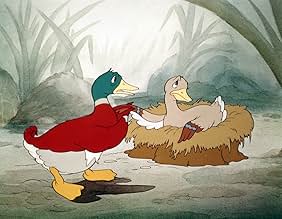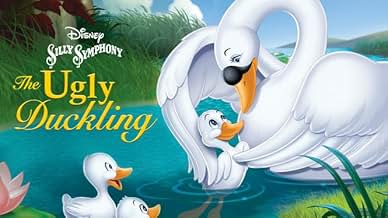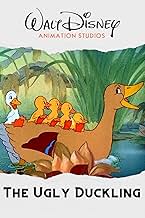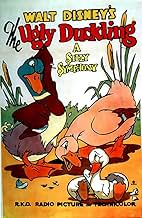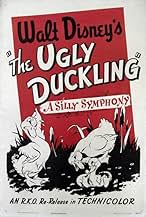PUNTUACIÓN EN IMDb
7,6/10
4 mil
TU PUNTUACIÓN
Un patito es rechazado por su familia porque es diferente. También es rechazado por todas las demás aves y animales. Finalmente, una madre cisne lo adopta como uno de sus hijos.Un patito es rechazado por su familia porque es diferente. También es rechazado por todas las demás aves y animales. Finalmente, una madre cisne lo adopta como uno de sus hijos.Un patito es rechazado por su familia porque es diferente. También es rechazado por todas las demás aves y animales. Finalmente, una madre cisne lo adopta como uno de sus hijos.
- Dirección
- Guión
- Reparto principal
- Ganó 1 premio Óscar
- 1 premio en total
Amanda Cewel
- Mother Duck (speaking)
- (sin acreditar)
Tom Cotry
- Father Duck (speaking)
- (sin acreditar)
Reseñas destacadas
'Ugly Duckling (1939)' was the final film in Disney's "Silly Symphonies" series, and was also their only remake of a previous Symphony. Wilfred Jackson's 'The Ugly Duckling (1931)' was a rather primitive black-and-white adaptation of Hans Christian Anderson's famous tale, which drastically altered the original story to make (at least in my interpretation) a rather touching plea for racial tolerance. Jack Cutting's 1939 film is considerably more polished, animated in vivid Technicolor that speaks to the extraordinary degree of prestige that Walt Disney's company enjoyed throughout the 1930s. It is also considerably more faithful to Anderson's story, following the "ugly duckling" around the pond as he attempts to find his place in society. Unlike the 1931 duckling, which was somewhat grotesquely, Cutting's version is cute and likable, if a bit gawky compared to his ostensible siblings. Nevertheless, either bird, however handsomely they are drawn, will immediately capture your heart with their wide-eyed innocence, amplified tenfold by the persecution that they much endure for simply being "different."
The duckling's hatching causes much consternation at the adult ducks' nest, with the father understandably anxious that his wife has apparently given birth to a youngster that quite obviously didn't inherit his genes. After being unceremoniously banished from the duck family, the "ugly duckling" strikes out alone, desperate to find somewhere where he can be accepted for who he is. Glancing down into his reflection on the pond surface, in one of the short's most touching moments, the duckling sees his own reflection, hideously distorted by the water ripples, and breaks into tears. Fortunately, a happy ending is just around the corner, and the duckling's lonely honks of despair are answered in kind by a family of swans, who immediately take our hero under their wing, so to speak. Unfaultable in terms of animation, music and characterisation, 'Ugly Duckling' is a touching celebration of accepting and savouring one's own differences, and was justly awarded with an Oscar for Best Animated Short Film, Disney's seventh Silly Symphony to do so.
The duckling's hatching causes much consternation at the adult ducks' nest, with the father understandably anxious that his wife has apparently given birth to a youngster that quite obviously didn't inherit his genes. After being unceremoniously banished from the duck family, the "ugly duckling" strikes out alone, desperate to find somewhere where he can be accepted for who he is. Glancing down into his reflection on the pond surface, in one of the short's most touching moments, the duckling sees his own reflection, hideously distorted by the water ripples, and breaks into tears. Fortunately, a happy ending is just around the corner, and the duckling's lonely honks of despair are answered in kind by a family of swans, who immediately take our hero under their wing, so to speak. Unfaultable in terms of animation, music and characterisation, 'Ugly Duckling' is a touching celebration of accepting and savouring one's own differences, and was justly awarded with an Oscar for Best Animated Short Film, Disney's seventh Silly Symphony to do so.
10llltdesq
Disney's track record for adaptations of works of literature is decidedly mixed. This version of Hans Christian Andersen's, "The Ugly Duckling" is one of the most successful ones and quite deservedly won another Oscar for Uncle Walt. It's a beautiful short on all counts-animation, backgrounds, artwork, scoring, eveything-Disney at it's best. When Disney was at their best, no one could touch them. This short does justice to one of the most well-known fairy tales of all time and almost makes up for what they did to Felix Salten's "Bambi". Almost. This one should be in-print and runs on The Ink and Paint Club. An absolute masterpiece and anyone who loves animation has got to see this one! Recommended.
For ten years, Walt Disney's talented animators pumped out cartoon after cartoon for his 'Silly Symphonies.' Walt decided it was time to shut down one of animation's most successful series. The final film of the 'Silly Symphonies' was April 1939's "The Ugly Duckling." The series went out with a bang, with the duck short winning the Academy Award for Best Short Subject (Cartoon), the 'Silly Symphonies' eighth Oscar win. The 75-cartoon series proved to be an invaluable testing ground for Disney to create and test new techniques and technologies, resulting in Walt's first feature film, 1938's "Snow White and the Seven Dwarfs."
Disney's animators, led by Jack Cutting and Ham Luske, had completed Hans Christian Andersen's fairy tale cartoon the year before. But Walt elected to hold off its release until he secured a Radio City Music Hall premier during the Easter Week which happened to front-end Fred Astaire and Ginger Rogers' "The Story of Vernon and Irene Castle." The 1939 version of "The Ugly Duckling" was his second telling of the 1843 Andersen story about a newly hatched white duckling who clearly didn't belong to the brood of baby mallard ducks the mother had just delivered. The most recent version was much sadder than its 1931 black-and-white predecessor, which played up the humorous aspects of the tale. But the Oscar-winning 1939 cartoon's ending was more in line with the written Andersen work than the earlier one.
"The Ugly Duckling" of 1939 concluded the 'Silly Symphonies'' storied series beginning in 1929 with "The Skeleton Dance." The string of successive cartoons was intended to be a platform for mainly musically-based animations with very little yapping. Over the course of its ten-year lifespan, the symphonies introduced a variety of innovations in animation, including the first three-strip Technicolor cartoon in 1932's "Flowers and Trees," special effects, more realistic human and animal movements, the multi-plane camera, and on and on. Only the cartoon series 'Tom and Jerry' would achieve the number of Academy Award wins as the 'Silly Symphonies.' After the overwhelming success of "Snow White," Walt decided to concentrate on his ambitious full-length films and his Mickey Mouse shorts. Some say the spirit of the series was carried on by his all-musical animated feature film, 1941's "Fantasia."
Disney's animators, led by Jack Cutting and Ham Luske, had completed Hans Christian Andersen's fairy tale cartoon the year before. But Walt elected to hold off its release until he secured a Radio City Music Hall premier during the Easter Week which happened to front-end Fred Astaire and Ginger Rogers' "The Story of Vernon and Irene Castle." The 1939 version of "The Ugly Duckling" was his second telling of the 1843 Andersen story about a newly hatched white duckling who clearly didn't belong to the brood of baby mallard ducks the mother had just delivered. The most recent version was much sadder than its 1931 black-and-white predecessor, which played up the humorous aspects of the tale. But the Oscar-winning 1939 cartoon's ending was more in line with the written Andersen work than the earlier one.
"The Ugly Duckling" of 1939 concluded the 'Silly Symphonies'' storied series beginning in 1929 with "The Skeleton Dance." The string of successive cartoons was intended to be a platform for mainly musically-based animations with very little yapping. Over the course of its ten-year lifespan, the symphonies introduced a variety of innovations in animation, including the first three-strip Technicolor cartoon in 1932's "Flowers and Trees," special effects, more realistic human and animal movements, the multi-plane camera, and on and on. Only the cartoon series 'Tom and Jerry' would achieve the number of Academy Award wins as the 'Silly Symphonies.' After the overwhelming success of "Snow White," Walt decided to concentrate on his ambitious full-length films and his Mickey Mouse shorts. Some say the spirit of the series was carried on by his all-musical animated feature film, 1941's "Fantasia."
A Walt Disney SILLY SYMPHONY Cartoon Short.
A gawky UGLY DUCKLING, only moments after birth, is hectored & harried from the family of ducks he was born into. Will he ever find happiness & learn his true destiny?
This is a pleasant cartoon, with the plucky personality of the protagonist firmly front & center; the by-play between the duck parents is also amusing. Based on the Hans Christian Andersen classic, it is a remake of a 1931 black & white Symphony. The SILLY SYMPHONIES ended with this film, but they went out with a bang - like 6 of its predecessors, THE UGLY DUCKLING was awarded an Oscar for Best Animation.
The SILLY SYMPHONIES, which Walt Disney produced for a ten year period beginning in 1929, are among the most fascinating of all animated series. Unlike the Mickey Mouse cartoons in which action was paramount, with the Symphonies the action was made to fit the music. There was little plot in the early Symphonies, which featured lively inanimate objects and anthropomorphic plants & animals, all moving frantically to the soundtrack. Gradually, however, the Symphonies became the school where Walt's animators learned to work with color and began to experiment with plot, characterization & photographic special effects. The pages of Fable & Fairy Tale, Myth & Mother Goose were all mined to provide story lines and even Hollywood's musicals & celebrities were effectively spoofed. It was from this rich soil that Disney's feature-length animation was to spring. In 1939, with SNOW WHITE successfully behind him and PINOCCHIO & FANTASIA on the near horizon, Walt phased out the SILLY SYMPHONIES; they had run their course & served their purpose.
A gawky UGLY DUCKLING, only moments after birth, is hectored & harried from the family of ducks he was born into. Will he ever find happiness & learn his true destiny?
This is a pleasant cartoon, with the plucky personality of the protagonist firmly front & center; the by-play between the duck parents is also amusing. Based on the Hans Christian Andersen classic, it is a remake of a 1931 black & white Symphony. The SILLY SYMPHONIES ended with this film, but they went out with a bang - like 6 of its predecessors, THE UGLY DUCKLING was awarded an Oscar for Best Animation.
The SILLY SYMPHONIES, which Walt Disney produced for a ten year period beginning in 1929, are among the most fascinating of all animated series. Unlike the Mickey Mouse cartoons in which action was paramount, with the Symphonies the action was made to fit the music. There was little plot in the early Symphonies, which featured lively inanimate objects and anthropomorphic plants & animals, all moving frantically to the soundtrack. Gradually, however, the Symphonies became the school where Walt's animators learned to work with color and began to experiment with plot, characterization & photographic special effects. The pages of Fable & Fairy Tale, Myth & Mother Goose were all mined to provide story lines and even Hollywood's musicals & celebrities were effectively spoofed. It was from this rich soil that Disney's feature-length animation was to spring. In 1939, with SNOW WHITE successfully behind him and PINOCCHIO & FANTASIA on the near horizon, Walt phased out the SILLY SYMPHONIES; they had run their course & served their purpose.
The Ugly Duckling, based on the story by Hans Christian Andersen, is a beautiful short, that not only has a wonderful message(being different can be good) but also has sentimental value. The animation, in Technicolour is truly lovely, and the music is one of the reasons why I have a soft spot for this short, it was so beautiful. The story of the short is simple, and sweet, and doesn't change the message of the original story. The ugly Duckling himself (which of course he isn't)is a really sweet and engaging title character, and when he cries, I can't help it, but so do I, because I really feel for him. He was created so beautiful, that it tugged at my heartstrings when he's sad. And when I saw the Ugly Duckling cuddling his newfound mother, I couldn't help cheering, seeing him so happy. The other characters are also well done. Overall, this is just beautiful, but I warn you, prepare for tears, when watching this, and this is for the title character alone. 10/10 Bethany Cox.
¿Sabías que...?
- CuriosidadesThe last Silly Symphony cartoon. Also, the only one to be a remake (of El patito feo (1931)).
- PifiasWhen the hero is reunited with his family, we discover that he is one of five baby swans. However, for a brief moment, six baby swans appear on screen as they swim around one another before returning to their mother.
- ConexionesEdited into Walt Disney Cartoon Classics Volume 5: Disney's Best of 1931-1948 (1983)
- Banda sonoraBorn to Ugly Duckling
(uncredited)
Traditional
Performed by studio orchestra
Selecciones populares
Inicia sesión para calificar y añadir a tu lista para recibir recomendaciones personalizadas
Detalles
- Duración9 minutos
- Relación de aspecto
- 1.37 : 1
Contribuir a esta página
Sugerir un cambio o añadir el contenido que falta

Principal laguna de datos
By what name was El patito feo (1939) officially released in Canada in English?
Responde
